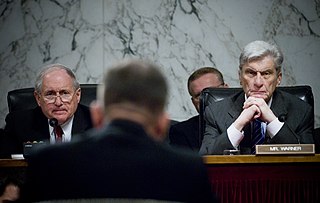Related Research Articles

ASCII, abbreviated from American Standard Code for Information Interchange, is a character encoding standard for electronic communication. ASCII codes represent text in computers, telecommunications equipment, and other devices. Because of technical limitations of computer systems at the time it was invented, ASCII has just 128 code points, of which only 95 are § printable characters, which severely limited its scope. All modern computer systems instead use Unicode, which has millions of code points, but the first 128 of these are the same as the ASCII set.

The American National Standards Institute is a private non-profit organization that oversees the development of voluntary consensus standards for products, services, processes, systems, and personnel in the United States. The organization also coordinates U.S. standards with international standards so that American products can be used worldwide.

In chemistry, pH, historically denoting "potential of hydrogen", is a scale used to specify the acidity or basicity of an aqueous solution. Acidic solutions are measured to have lower pH values than basic or alkaline solutions.

The Gramm–Rudman–Hollings Balanced Budget and Emergency Deficit Control Act of 1985 and the Balanced Budget and Emergency Deficit Control Reaffirmation Act of 1987 were the first binding spending constraints on the federal budget.
The United States Government Publishing Office is an agency of the legislative branch of the United States Federal government. The office produces and distributes information products and services for all three branches of the Federal Government, including U.S. passports for the Department of State as well as the official publications of the Supreme Court, the Congress, the Executive Office of the President, executive departments, and independent agencies.

The Blaine Act, formally titled Joint Resolution Proposing the Twenty-First Amendment to the United States Constitution, is a joint resolution adopted by the United States Congress on February 20, 1933, initiating repeal of the 18th Amendment to the United States Constitution, which established Prohibition in the United States. Repeal was finalized when the 21st Amendment to the Constitution was ratified by the required minimum number of states on December 5, 1933.

A congressional committee is a legislative sub-organization in the United States Congress that handles a specific duty. Committee membership enables members to develop specialized knowledge of the matters under their jurisdiction. As "little legislatures", the committees monitor ongoing governmental operations, identify issues suitable for legislative review, gather and evaluate information, and recommend courses of action to their parent body. Woodrow Wilson once wrote, "it is not far from the truth to say that Congress in session is Congress on public exhibition, whilst Congress in its committee rooms is Congress at work." It is not expected that a member of Congress be an expert on all matters and subject areas that come before Congress. Congressional committees provide valuable informational services to Congress by investigating and reporting about specialized subjects.
The Joint Committee on the Library is a Joint Committee of the United States Congress devoted to the affairs and administration of the Library of Congress, which is the library of the federal legislature. There are five members of each house on the committee. It has no subcommittees.

Acid-free paper is paper that, if infused in water, yields a neutral or basic pH. It can be made from any cellulose fiber as long as the active acid pulp is eliminated during processing. It is also lignin- and sulfur-free. Acid-free paper addresses the problem of preserving documents and preserving artwork for long periods.

The United States Senate Committee on the Judiciary, informally the Senate Judiciary Committee, is a standing committee of 22 U.S. senators whose role is to oversee the Department of Justice (DOJ), consider executive and judicial nominations, as well as review pending legislation.

The United States Senate Committee on Homeland Security and Governmental Affairs is the chief oversight committee of the United States Senate. It has jurisdiction over matters related to the Department of Homeland Security and other homeland security concerns, as well as the functioning of the government itself, including the National Archives, budget and accounting measures other than appropriations, the Census, the federal civil service, the affairs of the District of Columbia and the United States Postal Service. It was called the United States Senate Committee on Governmental Affairs before homeland security was added to its responsibilities in 2004. It serves as the Senate's chief investigative and oversight committee. Its chair is the only Senate committee chair who can issue subpoenas without a committee vote.

The United States House Committee on House Administration deals with the general administration matters of the United States House of Representatives.
A technical report is a document that describes the process, progress, or results of technical or scientific research or the state of a technical or scientific research problem. It might also include recommendations and conclusions of the research. Unlike other scientific literature, such as scientific journals and the proceedings of some academic conferences, technical reports rarely undergo comprehensive independent peer review before publication. They may be considered as grey literature. Where there is a review process, it is often limited to within the originating organization. Similarly, there are no formal publishing procedures for such reports, except where established locally.
The National Information Standards Organization is a United States non-profit standards organization that develops, maintains and publishes technical standards related to publishing, bibliographic and library applications. It was founded in 1939 as the "Z39 Committee", incorporated as a not-for-profit education association in 1983, and assumed its current name in 1984.
X3J13 is the name of a technical committee which was part of the International Committee for Information Technology Standards. The X3J13 committee was formed in 1986 to draw up an American National Standards Institute (ANSI) Common Lisp standard based on the first edition of the book Common Lisp the Language, by Guy L. Steele Jr., which was formerly a de facto standard for the language. The primary output of X3J13 was an American National Standard for programming language Common Lisp (X3.226/1994), approved December 8, 1994. X3J13 later worked with International Organization for Standardization (ISO) working group SC22/WG16 on an internationally standardised dialect of Lisp named ISLISP.
The Joint Committee on Printing is a joint committee of the United States Congress devoted to overseeing the functions of the Government Publishing Office and general printing procedures of the federal government of the United States. The authority vested in the Committee is derived from 44 U.S.C. § 101 and the Committee is thereby responsible for ensuring compliance by federal entities to these laws and the Government Printing and Binding Regulations. The current joint committee was created by the Legislative Reorganization Act of 1946 and combined the functions of the United States House Committee on Printing and the United States Senate Committee on Printing.
The Parental Rights Amendment to the United States Constitution is a proposed change to the United States Constitution. The amendment's advocates say that it will allow parents' rights to direct the upbringing of their children, protected from federal interference, and the United Nations Convention on the Rights of the Child. The Amendment was first proposed during the 110th Congress as House Joint Resolution 97 in July 2008, but no action was taken during that Congress. The Amendment has been described as a "wedge issue" and part of the culture wars.

LIA - The Laser Institute is an international professional society with a focus on laser applications and laser safety. LIA was founded on February 7, 1968, as the Laser Industry Association, and acts as secretariat to the Accredited Standards Committee (ASC) Z136, which develops and maintains the Z136 series of laser safety standards. LIA is publisher of these American National Standards Institute (ANSI) Z136 laser safety standards, which provide the foundation of laser safety programs nationally.
The Worker Protection Standard is intended to protect employees on farms, forests, nurseries, and greenhouses that are occupationally exposed to agricultural pesticides.
References
- ↑ "104 Stat. 912 - Joint resolution to establish a national policy on permanent papers". www.govinfo.gov. Retrieved December 13, 2017.
- ↑ "Conservation OnLine - CoOL". palimpsest.stanford.edu. Retrieved 2017-12-14.
- ↑ Congressional Record 135, Session 101-1
- ↑ Congressional Record 136, Session 101-2
- ↑ "Executive Order 13101" (PDF). Government Publishing Office. September 14, 1998.
- ↑ "GPO Releases New Paper Specification Standards" (PDF). Archived from the original (PDF) on September 30, 2007. Retrieved May 1, 2007.